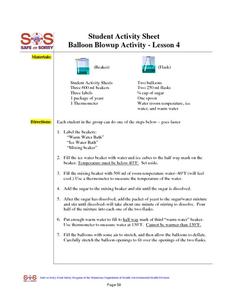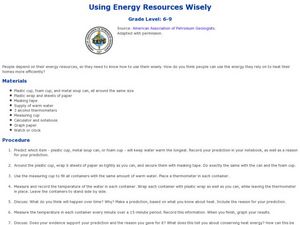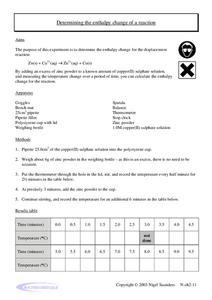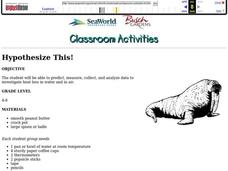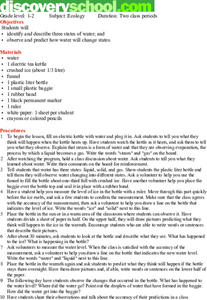Curated OER
Balloon Blowup Activity
In this science activity worksheet, students will work in small groups to observe and record what happens to balloons after they are placed on flasks and immersed into a warm water bath and an ice water bath.
Curated OER
Keeping Warm
Fifth graders measure the temperature of water using a thermometer. They record the temperatures of water on a chart. Students use the temperature data to determine which materials are the best conductors of heat. They discuss their...
Curated OER
Using Energy Resources Wisely
Students discuss energy resources. In this energy lesson, students predict which item: the plastic cup, metal soup can, or foam cup, will keep water warm for the longest time by measuring the temperature in each item every minute for 15...
Curated OER
Today's Temperature
Students study freezing temperatures and practice taking temperature readings with a thermometer. They write about a personal experience with weather. They discuss that the freezing point is at 32?? and that any water outside will...
Curated OER
Oceanic Heat Budget Activities
Learners map and research imaginary islands located in different parts of the world. They describe the weather and climate of their island and show how local currents, water temperatures and waves may influence the weather patterns.
Curated OER
Determining the Enthalpy Change of a Reaction
In this enthalpy of reactions worksheet, learners use a known amount of copper (II) sulphate solution and an excess of zinc powder to calculate the enthalpy change of the reaction. Students measure the temperature change over the course...
Curated OER
Radiation and Color
Tenth graders explore the relationship between color and heat absorption by measuring the temperature change of water in differently colored test tubes as they are exposed to a heat lamp. They work in small groups to collect data and...
Curated OER
Stream Study
Students study the characteristics of a stream habitat. In this life science lesson, students use sieves, nets, and jars to collect aquatic organisms. Students also measure the temperature of the stream and calculate the speed of the...
Curated OER
Creek Monitoring
Sixth graders conduct a variety of assessments at a local stream to determine if it is a suitable habitat for salmon. They measure temperature, tubidity, dissolved oxygen, pH levels, bacteria and nutrients. In this unit, 6th graders work...
Curated OER
Cool Times with Heat
Learners work with thermometers to complete problems about temperature. They investigate cooling patterns, how location affects temperature, and what happens when water having different temperature is mixed. They measure temperature in...
Curated OER
HYPOTHESIZE THIS!
Students predict, measure, collect, and analyze data to investigate heat loss in water and in air.
Curated OER
Salinity
Learners define and discuss salinity, conduct classroom experiment to determine salinity of water sample by using hydrometer, record predictions, and demonstrate understanding of how salinity influences object's ability to float in water.
Curated OER
When You're Hot, You're Hot!
Eighth graders examine the development of the different temperature scales. They experiment with hot and cold temperatures.
Curated OER
The Greenhouse Effect
In this greenhouse effect worksheet, students experiment with how the greenhouse effect affects the Earth's temperature by using thermometers, a plastic bag, cans, and water. Students also answer 4 questions.
Curated OER
Water 3: Melting and Freezing
Students understand that most substances may exist as solids, liquids, or gases depending on the temperature, pressure, and nature of that substance. This knowledge is critical to understanding that water in our world is constantly...
Curated OER
Making a Thermometer
Students observe a demonstration of how a thermometer functions. They apply the scientific method while determining which of three cups hold the coldest water. They write a hypothesis before conducting the experiment and gather data.
Teach Engineering
Weather Basics
Weather — there's more to it than meets the eye of the storm. With this resource young meteorologists learn about the basics of weather, including information about the factors that influence the weather, common weather vocabulary, and...
Nuffield Foundation
Measuring the Rate of Metabolism
Plant respiration can be a difficult concept for young biologists to grasp; with a hands-on lab, learners can collect and graph data, then calculate the metabolism rate for the plants they studied. If you do not have a respirometer,...
Curated OER
An alternative Temperature Measurement
Learners will observe an alternative method of temperature measurement. In this scientific measurement lesson, students observe and discuss alternative systems used to measure temperature.
Curated OER
Energy from the Sun
In this energy worksheet, learners conduct an experiment and observe the various ways in which heat energy can be transferred. They explain what happened to the wooden block when it was placed in direct sunlight. Students also explain...
Curated OER
Heating the Atmosphere
Students construct a thermograph for maximum and minimum temperatures for the 2-week period. They illustrate how the earth's atmosphere is heated by convection and conduction currents and evaporation of water.
Curated OER
Ice Cream Blizzards
Fourth graders explore whether the making of homemade ice cream is a physical change or a chemical change in a lab experiment. Students identify states of matter, describe the physical properties of states, and collect temperature data...
Curated OER
How Does a Thermometer Work?
Students explore how a thermometer works. In this temperature instructional activity, students use a glass bottle, a straw, and food coloring to construct a homemade thermometer. Students record observations.
Curated OER
Ecology
Students identify and describe three states of water. They predict how water will change states.


